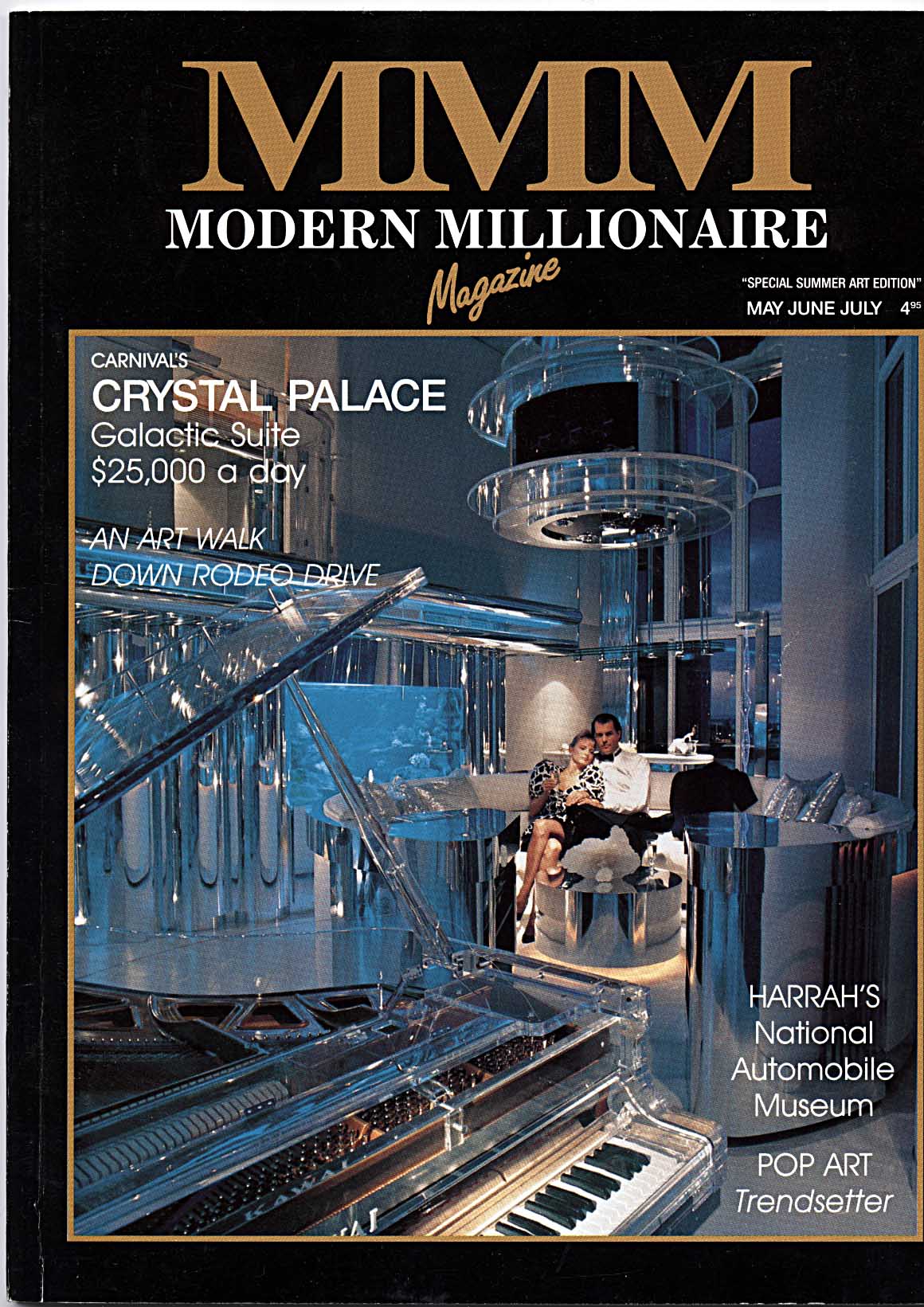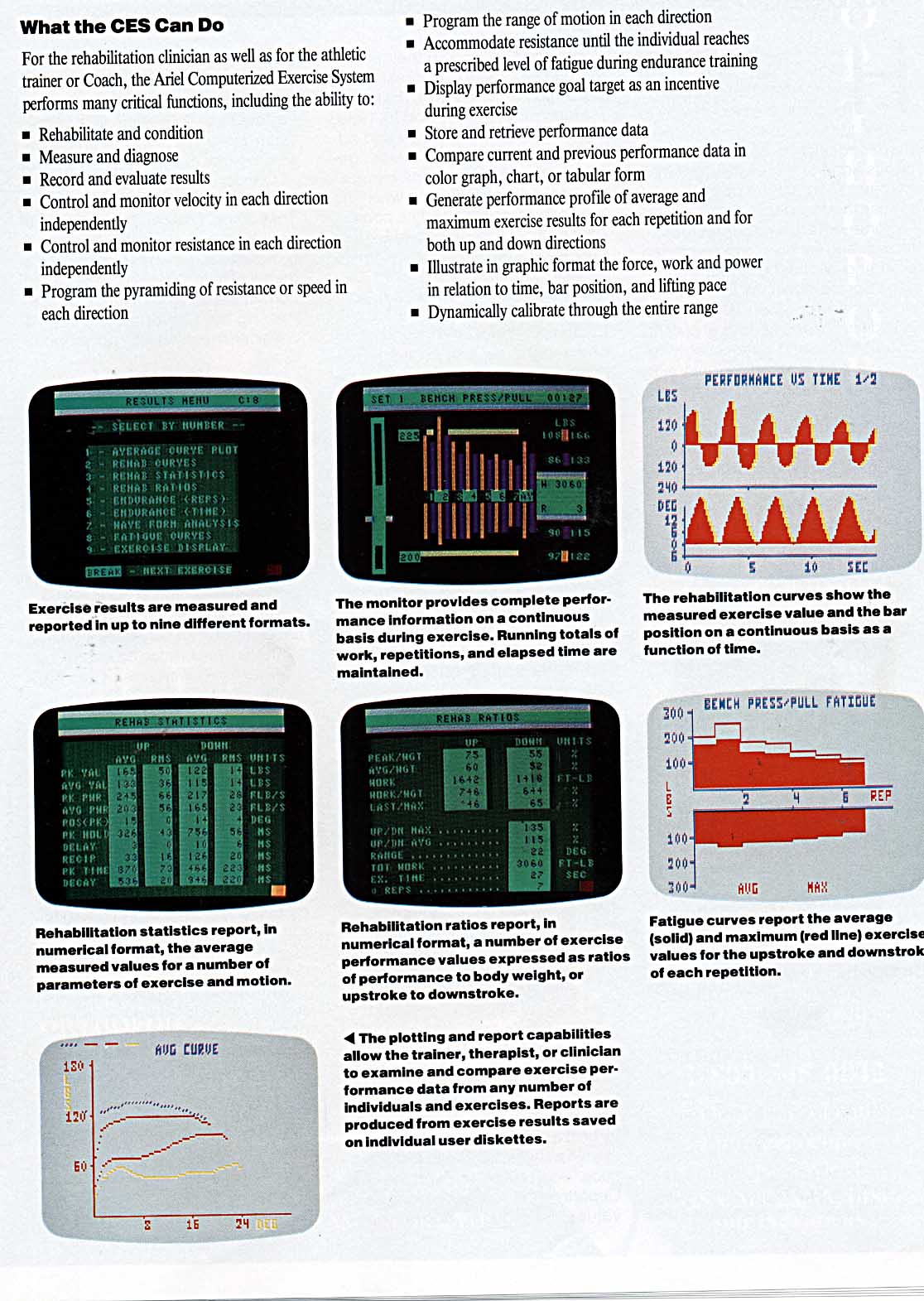Sports Science
science of sports and biomechanics is produced, packaged and perfected
By Suzanne Tucker in Modern Millionaire Magazine on Wednesday, May 1, 1985
Sports Science: The Future of Fitness
In this article, Suzanne Tucker explores the future of fitness and exercise, focusing on the role of sports science. She highlights the work of sports scientist Gideon Ariel Ph.D, who has developed the Ariel CES 5000 exercise system. This system can monitor and adjust to muscle needs over 2000 times per second, making it ideal for both earth-based and space-based exercise.
The article also discusses the use of biomechanics in sports, with a focus on tennis. Vic Braden, a former professional tennis player, emphasizes the importance of biomechanics in improving tennis strokes and overall performance.
The article concludes by discussing the potential of home-based exercise systems like the Ariel 5000, which can provide efficient and personalized workouts. The author also mentions the advanced sports science techniques used by the Soviets, suggesting that Americans can optimize their training time by adopting similar methods.
Tip: use the left and right arrow keys
HEALTH & FITNESS
SPORTS SCIENCE
By Suzanne Tucker
Well, exercise fans, let's take a look into the crystal ball for the '90s. Which new fat burners or diets are going to be hot on the eve of the 21st century? What space-age devices will get - and keep - you slim? If we take the responsible apporach, we will look to the sports scientists. In the seductive and sensuous community of Coto de Caza, Ca., where teal skies frame pastoral estates bordered by exercise and equestrian trails, the science of sports and biomechanics is produced, packaged and perfected.
A sports scientist utilizes physiology, kinesiology, psychology, physics, chemistry
and biomechanics as his tools for solving your total exercise needs. When one initially scans over the list of all these "ologies", it appears you must be a rocket scientist to understand them all.
Actually, one of the pioneers in modern sports science does have an involvement in space experiements. Gideon Ariel Ph.d, the inventor of the Ariel CES 5000 exercise system that can monitor and adjust to your muscles' needs over 2000 times per second, not only is interested in healthy bodies on earth, but also in space. "In zero gravity the astronaut's muscles do not have to work as hard so they suffer from atrophy (the muscle withers away) on long missions," explains Ariel.
Ariel and NASA investigate these problems with the help of two elaborate microcomputers. The first is the microcomputer-driven exercise machine that is unrivaled in its capabilities. It allows workouts to be tailored to each individual's needs. The computer stores your personal data automatically each and every workout. It adjusts the resistance within each repetition to insure maximum intensity throughout the muscle's entire range of motion. This task cannot be accom
plished by free weights or weightstack style machines in clubs. Instead of lugging 15 or 20 machines into outer space, the versatile Ariel CES 5000 takes up little space and can keep the astronaut's whole body strong.
By using digitized video pictures, a second sports science tool analyzes the forces acting on the body. The study of these forces and effects is called biomechanics. The Ariel Performance Analysis system allows coaches to examine technique flaws in athletics that occur faster than the human eye can record.
Down here on earth, sports biomechanics is being used more and more, but is not yet near its potential, according to Dr. Adel. One sports scientist making the world aware of the need for biomechanics in tennis is nestled less than two miles from Ariel Center in the dreamy mountainside community of Coto de Caza, Ca. Vic Braden, former professional tennis player with a Ph.D. in psychology and a brand spanking new $600,000 hi-tech video center, knows the importance of biomechanics in sport. "At my Tennis College we tell our students, 'Tennis is an engineering problem. If you have a good attitude and poor strokes, you'll be a happy loser.'"
Tennis, when played properly, is an excellent form of cardiorespiratory exercise but can be frustrating or exhilirating, depending on your ability to hit the ball. "Show me someone who has got great strokes and it's hard to find a bad attitude. People don't often say, 'Nuts, won again!'" One way Braden tries to help you "Laugh and Win" is to let you view your strokes in slow motion.
During your Hollywood career at the Vc Braden Tennis College you will meet up with the next generation of sports scientist. Jimmy Shaughnessy is the video biomechanics analyst at the
Digitized video tracks a body's motion.
Athletes can analyze technique for flaws the human eye misses.
E
Sports Science
Tennis College. "We produce a video of your strokes that shows your swing in slow motion. As you look at your swing you hear the biomechanist explain what you do well and not so well. Then you see one of our staff's mechanically correct strokes so you can compare the two." Braden's new video production center will soon be offering this service with professional video and audio quality.
Shaughnessy sees exercise in the nineties headed toward the home. "In the competitive world we live in, time is the most valuable commodity. Exercise tends to lengthen and enhance your life, but fitting exercise into your daily schedule can be a time based problem. With the Ariel 5000 not only can you bum approximately 35% more calories than free weights, 29% more than Nautilus, you can do it in half the workout time. This system is important for rehab and sports training now (i.e., Denver Broncos, Philadelphia Eagles, physical therapists, etc.), but its home fitness potential is truly phenomenal. Instead of an extra Mercedes you can buy the most efficient way to exercise your body. You won't need a car to drive to the fitness club, and it takes up less space too!"
While studying for his Masters at the United States Sports Academy, Shaughnessy studied intensely under Ariel and Michael Yessis Ph.D, editor of the Soviet Sports Review. Yessis, who has been educating America about the Soviet Union's scientific approach to fitness and athletics for over 22 years, says, "Most Americans don't know that the Soviets are very willing to discuss their methods." Yessis claims the Soviets "have the most advanced stereo-photographic, optico electronic, laser and telemetric registration techniques anywhere in the world." To say the least, this type of feedback can be a little more valuable than the typical output you get from the "No pain-No gain" style coach or personal fitness trainer. Yessis and Ariel agree that the Soviets excel because their coaches are more educated in the sports sciences (at least a Master's degree at international level). The fact is that Soviets optimize their training time. Now Americans can do the same.
111181
Gideon Ariel Phd
Jimmy Shaugnessy
HHi!Mr�HH t
~� ~ -H
MO ~!~ i
i~~NH .e11U
OONaOWNIEW H iiiiis
,
,+-t -t- -t-
Vic Braden Tennis College Coto de Casa Ca.
What the CES Can Do
For the rehabilitation clinician as well as for the athletic trainer or Coach, the Ariel Computerized Exercise System performs many critical functions, including the ability to:
� Rehabilitate and condition
� Measure and diagnose
� Record and evaluate results
� Control and monitor velocity in each direction
independently
� Control and monitor resistance in each direction
independently
� Program the pyramiding of resistance or speed in
each direction
� Program the range of motion in each direction
� Accommodate resistance until the individual reaches
a prescribed level of fatigue during endurance training
� Display performance goal target as an incentive
during exercise
� Store and retrieve performance data
� Compare current and previous performance data in
color graph, chart, or tabular form
� Generate performance profile of average and
maximum exercise results for each repetition and for
both up and down directions
� Illustrate in graphic format the force, work and power
in relation to time, bar position, and lifting pace
� Dynamically calibrate through the entire range
RESULTS MEMO - C'S
;- S~LECT RY NUMIER -
~t'�iiObT S
arlos
4
II $
PERFORMANCE U5 TIME 1/2
LIS
124
U
00
244 DEC
'y6
U S 10 SEC
Exercise results are measured and reported In up to nine different formats.
The monitor provides complete perfor. mance Information on a continuous basis during exercise. Running totals of work, repetitions, and elapsed time are maintained,
The rehabilitation curves show the measured exercise value and the bar position on a continuous basis as a function of time.
-RERRV TTATEtt1C
- UP PON";
M$ AV +RN UNITS
Lee Lis M.'s
RK'4tM>Mi ,MS
GRUAY'�1� Ms
REO I P' +MS
PR- T'I 'MS
sfOAY' rMS
REHAB RATIOS
UP DOM" UNITS
PEAK/MGT 75 SS
*V6/MGT 60 Ss Y.
MORE 1642 1415 FT -I
MORE/MOT 746 544 .X
LAST/MAX 46 6% r
UP/DN MAX 135 X
uP/PH AYG ... Its z
RANGE n . DEG
TOT- MORK r..:: FT-Ls
EX. TIME SEC
a REPS
Rehabilitation ratios report, In numerical format, a number of exercise performance values expressed as ratios of performance to body weight, or upstroke to downstroke.
1 The plotting and report capabilities allow the trainer, therapist, or clinician to examine and compare exercise performance data from any number of Individuals and exercises. Reports are produced from exercise results saved on individual user diskettes.
CEMCH PRESS/PULL FATIGUE
34U 200
100
L
E PEP
100
204
340 A!IC MAX
Fatigue curves report the average (solid) and maximum (red line) exercise values for the upstroke and downstrok of each repetition.
Rehabilitation statistics report, in numerical format, the average measured values for a number of parameters of exercise and motion.
15i~
05 CURVE
E0
16 24





